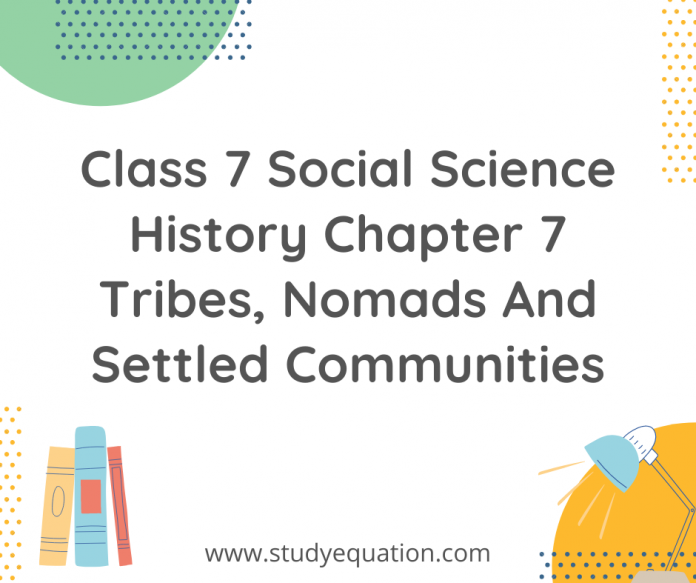NCERT Solutions For Class 7 Social Science History Chapter 7 Tribes, Nomads And Settled Communities. We also provide Notes and Lesson Plan. They are made specially by our Study Rankers for better understanding. Students may read the NCERT Social Science History Chapter 7 PDF to practice concepts with NCERT Solutions and Extra Questions and Answers. These are prepared by keeping in mind the latest CBSE curriculum. Shine among your friends after scoring high in Quiz, MCQ and Worksheet.
Read more: NCERT Solutions For Class 7 Social Science Geography Chapter 5 Water
Table of Contents
Notes For NCERT Solutions For Class 7 Social Science History Chapter 7 Tribes, Nomads And Settled Communities
(Also find NCERT Solutions For Class 7 Social Science History Chapter 7 Tribes, Nomads And Settled Communities given below)
- The rules of varna divided the society.
- The rulers of large kingdoms accepted these rules.
- The difference between the high and low, and between the rich and poor, increased.
- Under the Delhi Sultans and the Mughals, this hierarchy between social classes grew further
Beyond Big Cities: Tribal Societies
Some Basic Characteristics
- Many societies in the subcontinent did not follow the social rules and rituals prescribed by the Brahmanas.
- Numerous unequal classes did not divide them.
- Such societies are often called tribes.
- Kinship bonds united the members of these tribes.
- Agriculture provided livelihood to many tribes.
- Others were hunter-gatherers or herders.
- Nomadic tribes moved from one place to another.
- A tribal group controlled land and pastures jointly .
- They divided these amongst households according to its own rules.
- They usually lived in forests, hills, deserts, and places difficult to reach.
- In various ways, the tribes retained their freedom
- Tribes preserved their separate culture.
- This relationship, of conflict and dependence, gradually caused both societies to change.
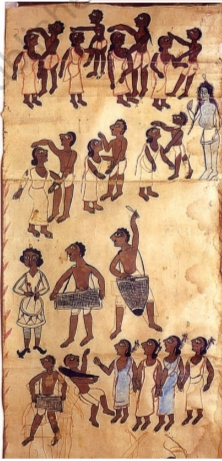
Who were Tribal People?
- They preserved rich customs and oral traditions.
- These oral traditions were passed down to new generations.
- Every region of the subcontinent had Tribal People.
- Some powerful tribes controlled large territories.
Region Of Khokhar Tribe
- In Punjab, the Khokhar tribe was very influential during the thirteenth and fourteenth centuries.
- Later, the Gakkhars became more important.
- Emperor Akbar made Kamal Khan Gakkhar, a noble (mansabdar).
Region of Langahs and Arghuns
- In Multan and Sind, the Langahs and Arghuns dominated extensive regions.
- But Mughals subdued them.
Region of Balochis
- The Balochis were another large and powerful tribe in the north-west.
- Many smaller clans under different chiefs divided them.
Region of Gaddis
- In the western Himalaya lived the shepherd tribe of Gaddis.
Region of Cheros
- In many areas of present-day Bihar and Jharkhand, Chero chiefdoms had emerged by the twelfth century.
- Raja Man Singh, Akbar’s famous general, attacked the Cheros.
- He defeated the Cheros in 1591.
- Raja Man Singh took a large amount of booty from them. But, he couldn’t entirely control them.
- Under Aurangzeb, Mughal forces captured many Chero fortresses. They crushed the tribe.
Region of Mundas and Santals
- The Mundas and Santals were among the other important tribes. They lived in this region. They also lived in Orissa and Bengal.
Region of Kolis and Berads
- The Maharashtra highlands and Karnataka were home to Kolis, Berads, and numerous others.
- Kolis also lived in many areas of Gujarat.
Region of Bhils
- Western and central India had the spread of the large tribe of Bhils.
- By the late sixteenth century, many of them had become settled agriculturists and some even zamindars.
- But, many Bhil clans remained hunter-gatherers.
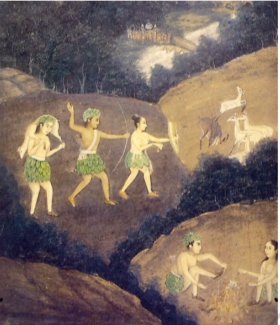
Region of Gonds
- Across the states of Chhattisgarh, Madhya Pradesh, Maharashtra, and Andhra Pradesh, spread the Gonds in great numbers.
Region of Miscellaneous Tribes
- Tribes like the Nagas, Ahoms, and many others dominated the distant north-eastern part of the subcontinent.
- Further south there were large tribal populations of Koragas, Vetars, Maravars, and many others.
How Nomads and Mobile People Lived
Nomads
- Nomads are wandering people.
- Many of them are pastoralists. They roam from one pasture to another with their flocks and herds.
- Nomads visit the same places every year.
- They lived on milk and other pastoral products.
- Nomads also exchanged wool, ghee, etc. They traded these with settled agriculturists for grain, cloth, utensils, and other products.
- Nomads bought and sold these goods as they moved from one place to another. They transported them on their animals.
The Banjaras
- The Banjaras were the most important trader-nomads.
- Tanda was the name of their caravan.
- They transported food grain for the Mughal army during military campaigns.
- With a large army, there could be 100,000 bullocks carrying grain.
- Sultan Alauddin Khalji used the Banjaras. He used them to transport grain to the city markets.
- Emperor Jahangir wrote in his memoirs that the Banjaras carried grain on their bullocks from different areas. Then they sold it in towns.
- Learn more about The Banjaras .
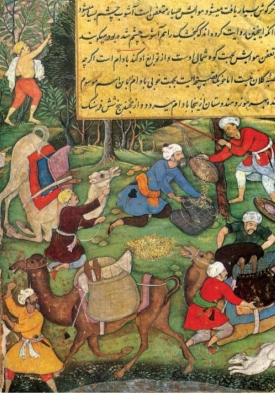
Itinerant Groups
- Itinerant groups, such as craftspersons, pedlars, and entertainers travel from place to place practicing their different occupations.
- Many pastoral tribes reared and sold animals. Such as cattle and horses, to the prosperous people.
- Different castes of petty pedlars also traveled from village to village.
- They made and sold wares such as ropes, reeds, straw matting, and coarse sacks.
- Sometimes mendicants acted as wandering merchants.
- There were castes of entertainers who performed in different towns for their livelihood. They also performed in villages.
Changing Society: New Castes and Heirarchies
Jatis
- As the economy and the needs of society grew, people with new skills were required.
- New castes appeared amongst the Brahmanas.
- Smaller castes, or jatis, emerged within varnas.
- Many tribes and social groups were taken into caste-based society. They were given the status of jatis.
- Specialized artisans – smiths, carpenters, and masons – were also recognized as separate jatis by the Brahmanas.
- Jatis, rather than varna, became the basis for organizing society.
- Gradually, with the support of the Brahmanas, many tribes became part of the caste system.
- But only the leading tribal families could join the ruling class.
- A large majority joined the lower jatis of caste society.
Rajputs
- Among the Kshatriyas, new Rajput clans became powerful by the eleventh and twelfth centuries.
- They belonged to different lineages, such as Hunas, Chandelas, Chalukyas, and others.
- Some of these, too, had been tribes earlier.
- Many of these clans came to be regarded as Rajputs.
- They gradually replaced the older rulers, especially in agricultural areas.
- Here a developed society was emerging. Rulers used their wealth to create powerful states.
- The rise of Rajput clans to the position of rulers set an example for the tribal people to follow.
- Many dominant tribes of Punjab, Sind, and the North-West Frontier had adopted Islam quite early.
- They continued to reject the caste system.
- The unequal social order, given by Hinduism, was not widely accepted in these areas.
- The emergence of states is closely related to social change amongst tribal people.
A Closer Look
The Gonds
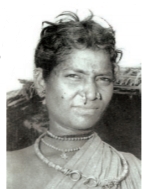
Some Facts
- The Gonds lived in a vast forested region called Gondwana. Also known as the “country inhabited by Gonds”.
- They practiced shifting cultivation.
- Many smaller clans divided the large Gond Tribe.
- Each clan had its own raja or rai.
Shifting Cultivation
- Trees and bushes in a forest area are first cut and burnt.
- The crop is sown in the ashes.
- When this land loses its fertility, another plot of land is cleared and planted in the same way.
Development
- Few large Gond kingdoms were beginning to dominate the smaller Gond chiefs. This was because the power of the Delhi Sultans was declining.
- You must have learned about the Delhi Sultans in History Chapter 1 .
- The administrative system of these kingdoms was becoming centralized.
The Gond Kingdom
- Different garhs divided the Kingdom.
- A particular Gond clan controlled each Garh.
- This was further divided into units of 84 villages called chaurasi.
- The chaurasi was subdivided into barhots. Barhots were made up of 12 villages each.
- This was further divided into units of 84 villages called chaurasi.
- A particular Gond clan controlled each Garh.
Societal Changes
- The emergence of large states changed the nature of Gond society.
- Unequal social classes gradually divided their equal society.
- Brahmanas received land grants from the Gond rajas. Hence, they became more influential.
- The Gond chiefs now wished to be recognized as Rajputs.
- So, Aman Das, the Gond raja of Garha Katanga, assumed the title of Sangram Shah.
- His son, Dalpat, married princess Durgawati. She wasthe daughter of Salbahan. He was the Chandel Rajput raja of Mahoba.
- Dalpat, however, died early.
Reign Of Rani Durgawati
- Rani Durgawati was very capable. She started ruling on behalf of her five-year-old son, Bir Narain.
- Under her, the kingdom became even more extensive.
- In 1565, the Mughal forces under Asaf Khan attacked Garha Katanga.
- Rani Durgawati put up strong resistance.
- Mughals defeated her. But she preferred to die rather than surrender.
- Her son, too, died fighting soon after.
Garha Katanga
- Garha Katanga was a rich state.
- The Akbar Nama, a history of Akbar’s reign, mentions the Gond kingdom. It says that the Garha Katanga that had 70,000 villages.
- It earned much wealth by trapping and exporting wild elephants to other kingdoms.
- The Mughals defeated the Gonds. They captured a huge booty of precious coins and elephants.
- They they took over a part of the kingdom. Mughals granted the rest to Chandra Shah, an uncle of Bir Narain.
- Despite the fall of Garha Katanga, the Gond kingdoms survived for some time.
- However, they became much weaker.
- Later, they struggled unsuccessfully against the stronger Bundelas and Marathas.
The Ahoms
History and Facts
- The Ahoms migrated to the Brahmaputra valley. They came from Myanmar in the thirteenth century.
- They created a new state by suppressing the older political system of the bhuiyans (landlords).
- During the sixteenth century, they took over the kingdoms of the Chhutiyas (1523) and Koch-Hajo (1581) and controlled many other tribes.
- The Ahoms built a large state. For this, they used firearms as early as the 1530s.
- By the 1660s they could even make high-quality gunpowder and cannons.
Facing Opposition
- The Ahoms faced many invasions from the south-west.
- In 1662, the Mughals under Mir Jumla attacked the Ahom kingdom.
- Mir Jumla defeated the Ahoms despite their brave defense.
- But direct Mughal control over the region could not last long.
- You must have learned about the Mughal Empire in History Chapter 4 .
Paiks
- The Ahom state depended upon forced labor.
- The state forced Paiks to work for the state.
- Each village had to send several paiks by rotation.
- People from heavily populated areas shifted to less populated places.
- Ahom clans were thus broken up.
- By the first half of the seventeenth century, the administration became quite centralized.
Day-to-day Activities
- Almost all adult males served in the army during the war.
- At other times, they engaged in building dams, irrigation systems, and other public works.
- The Ahoms also introduced new methods of rice cultivation.
Khels
- Clans or khels divided the Ahom society.
- There were very few castes of artisans. So, artisans in the Ahom areas came from the adjoining kingdoms.
- A Khel often controlled several villages.
- Peasant’s village community gave him land.
- Even the king could not take it away without the community’s consent.
Their Devotion
- Originally, the Ahoms worshipped their own tribal gods.
- During the first half of the seventeenth century, however, the influence of Brahmanas increased.
- The king granted land to temples and Brahmanas.
- In the reign of Sib Singh (1714-1744), Hinduism became the predominant religion.
- But the Ahom kings did not completely give up their traditional beliefs after adopting Hinduism.
Their Culture
- Ahom society was very sophisticated.
- Poets and scholars were given land grants.
- Ahoms encouraged theatre.
- Important works of Sanskrit were translated into the local language.
- Historical works, known as buranjis, were also written. First, they were written in the Ahom language and then in the Assamese.
The Mongols
- Mongols were the best-known pastoral and hunter-gatherer tribe in history.
- They inhabited the grasslands (steppes) of Central Asia and forested areas further north.
- By 1206, Genghis Khan had united the Mongol and Turkish tribes into a powerful military force.
- At the time of his death (1227) he was the ruler of extensive territories.
- His successors created a vast empire.
- At different points in time, it included parts of Russia, Eastern Europe, and also China, and much of West Asia.
- The Mongols had well-organized military. They also had administrative systems.
- These were based on the support of different ethnic and religious groups.
NCERT Solutions For Class 7 Social Science History Chapter 7 Tribes, Nomads And Settled Communities
(Also find NCERT Solutions For Class 7 Social Science History Chapter 7 Tribes, Nomads And Settled Communities given below)
Q. 1. Match the following:
| Garh | Khel |
| Tanda | Chaurasi |
| Laborer | Caravan |
| Clan | Garha Katanga |
| Sib Singh | Ahom State |
| Durgawati | Paik |
A)
| Garh | Chaurasi |
| Tanda | Caravan |
| Laborer | Paik |
| Clan | Khel |
| Sib Singh | Ahom State |
| Durgawati | Garha Katanga |
Q. 2. Fill in the blanks:
- The new castes emerging within varnas were called ……………………
- ……… were historical works written by the Ahoms.
- The …….. mentions that Garha Katanga had 70,000 villages.
- As tribal stales became bigger and stronger they gave land grants to …………..
A)
- The new castes emerging within varnas were called jatis.
- Buranjis were historical works written by the Ahoms.
- The Akbar Nama mentions that Garha Katanga had 70,000 villages.
- As tribal states became bigger and stronger they gave land grants to temples and Brahmanas.
Q. 3. State whether true or false:
- Tribal societies had rich oral traditions.
- There were no tribal communities in the north-western part of the subcontinent.
- The Chaurasi in Gond states contained several cities.
- The Bhils lived in the north-eastern part of the sub-continent.
A)
- Tribal societies had rich oral traditions. TRUE
- There were no tribal communities in the north-western part of the subcontinent. FALSE
- The Chaurasi in Gond states contained several cities. FALSE
- The Bhils lived in the north-eastern part of the sub-continent. FALSE
Q. 4. What kinds of exchanges took place between nomadic pastorals and settled agriculturists?
A)
- Many pastoral tribes reared and sold animals, such as cattle and horses, to the prosperous people.
- Petty peddlers made and sold wares such as ropes, reeds, straw matting, and coarse sacks.
- Nomads also exchanged wool, ghee, etc., with settled agriculturists for grain, cloth, utensils, and other products.
Q. 5. How was the administration of the Ahom state-organized?
A)
- The Ahom state depended upon forced labor.
- The state forced Paiks to work for the state.
- Each village had to send several paiks by rotation.
- People from heavily populated areas shifted to less populated places.
- Ahom clans were thus broken up.
- By the first half of the seventeenth century, the administration became quite centralized.
Q. 6. What changes took place in varna-based society?
A) The following changes took place in varna-based society:
- New castes appeared amongst the Brahmanas.
- Smaller castes, or jatis, emerged within varnas.
- Many tribes and social groups were taken into caste-based society and given the status of jatis.
- Specialized artisans – smiths, carpenters, and masons – were also recognized as separate jatis by the Brahmanas.
- Gradually, with the support of the Brahmanas, many tribes became part of the caste system.
- Brahmanas received land grants from the Gond rajas and became more influential.
- The Gond chiefs now wished to be recognized as Rajputs.
- So, Aman Das, the Gond raja of Garha Katanga, assumed the title of Sangram Shah.
Q. 7. How did tribal societies change after being organised into a state?
A)
- The emergence of large states changed the nature of Gond society.
- Unequal social classes gradually divided their equal society.
- Brahmanas received land grants from the Gond rajas and became more influential.
- The Gond chiefs now wished to be recognized as Rajputs.
- So, Aman Das, the Gond raja of Garha Katanga, assumed the title of Sangram Shah.
Q. 8. Were the Banjaras important for the economy?
A)
- The Banjaras were the most important trader-nomads.
- Tanda was the name of their caravan.
- They transported food grain for the Mughal army during military campaigns.
- With a large army, there could be 100,000 bullocks carrying grain.
- Sultan Alauddin Khalji used the Banjaras to transport grain to the city markets.
- Emperor Jahangir wrote in his memoirs that the Banjaras carried grain on their bullocks from different areas and sold it in towns.
Q. 9. In what ways was the history of the Gonds different from that of the Ahoms? Were there any similarities?
A) Differences in the histories of Gonds and Ahoms:
| GONDS | AHOMS |
| The Gonds lived in Gondwana – or “country inhabited by Gonds”. | The Ahoms migrated to the Brahmaputra valley from Myanmar in the thirteenth century. |
| Many smaller clans divided the large Gond Tribe. Each clan had its own raja or rai. | They created a new state. |
| Few large Gond kingdoms were beginning to dominate the smaller Gond chiefs, as the power of the Delhi Sultans was declining. | During the sixteenth century, they annexed the kingdoms of the Chhutiyas (1523) and Koch-Hajo (1581) and subjugated many other tribes. |
| They did not use firearms. | The Ahoms built a large state, and for this, they used firearms as early as the 1530s. By the 1660s they could even make high-quality gunpowder and cannons. |
| In 1565, the Mughal forces under Asaf Khan attacked Garha Katanga. | The Ahoms faced many invasions from the south-west. In 1662, the Mughals under Mir Jumla attacked the Ahom kingdom. |
Similarities between Ahoms and Gonds:
- The Mughals tried to control the lands of boththe societies.
- Both the societies were divided by different clans.
Some Frequently Asked Questions
(Here you can find the NCERT Solutions For Class 7 Social Science History Chapter 7 Tribes, Nomads And Settled Communities FAQs.)
Q. 1. Why the Mughals were interested in the land of Gonds?
A)
- Garha Katanga was a rich state and it was a large kingdom.
- The Akbar Nama, a history of Akbar’s reign, mentions the Gond kingdom of Garha Katanga that had 70,000 villages.
- It earned much wealth by trapping and exporting wild elephants to other kingdoms.
- Hence, Mughals were interested in the land of Gonds.
Q. 2. Why the Mughals were interested in the state of Ahoms?
A)
- The Ahoms built a large state.
- They used firearms as early as the 1530s.
- Ahoms could even make high-quality gunpowder and cannons.
- They engaged in building dams, irrigation systems, etc.
- The Ahoms also introduced new methods of rice cultivation.
- Ahom society was very sophisticated.
- Poets and scholars were given land grants.
- They encouraged theatre.
- Hence, Mughals were interested in the state of Ahoms.
Conclusion: NCERT Solutions For Class 7 Social Science History Chapter 7 Tribes, Nomads And Settled Communities
Above written includes NCERT Solutions For Class 7 Social Science History Chapter 7 Tribes, Nomads And Settled Communities, detailed Explanation, and Question Answers. Browse our site for various detailed and easy NCERT Solutions and CBSE Notes.

